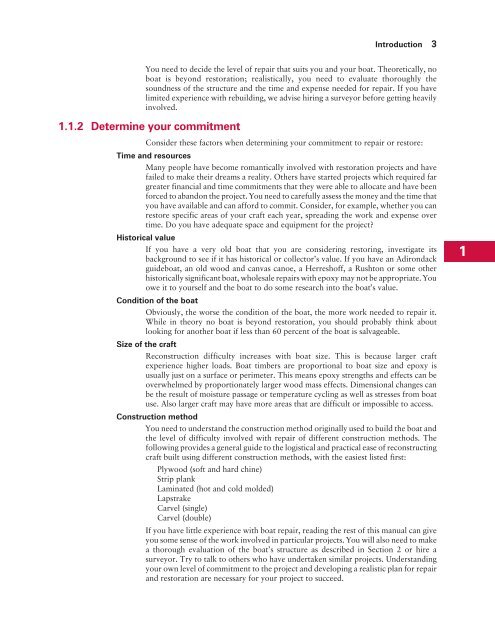Wooden Boat Restoration Repair - WEST SYSTEM Epoxy
Wooden Boat Restoration Repair - WEST SYSTEM Epoxy
Wooden Boat Restoration Repair - WEST SYSTEM Epoxy
You also want an ePaper? Increase the reach of your titles
YUMPU automatically turns print PDFs into web optimized ePapers that Google loves.
You need to decide the level of repair that suits you and your boat. Theoretically, no<br />
boat is beyond restoration; realistically, you need to evaluate thoroughly the<br />
soundness of the structure and the time and expense needed for repair. If you have<br />
limited experience with rebuilding, we advise hiring a surveyor before getting heavily<br />
involved.<br />
1.1.2 Determine your commitment<br />
Introduction 3<br />
Consider these factors when determining your commitment to repair or restore:<br />
Time and resources<br />
Many people have become romantically involved with restoration projects and have<br />
failed to make their dreams a reality. Others have started projects which required far<br />
greater financial and time commitments that they were able to allocate and have been<br />
forced to abandon the project. You need to carefully assess the money and the time that<br />
you have available and can afford to commit. Consider, for example, whether you can<br />
restore specific areas of your craft each year, spreading the work and expense over<br />
time. Do you have adequate space and equipment for the project?<br />
Historical value<br />
If you have a very old boat that you are considering restoring, investigate its<br />
background to see if it has historical or collector’s value. If you have an Adirondack<br />
guideboat, an old wood and canvas canoe, a Herreshoff, a Rushton or some other<br />
historically significant boat, wholesale repairs with epoxy may not be appropriate. You<br />
owe it to yourself and the boat to do some research into the boat’s value.<br />
Condition of the boat<br />
Obviously, the worse the condition of the boat, the more work needed to repair it.<br />
While in theory no boat is beyond restoration, you should probably think about<br />
looking for another boat if less than 60 percent of the boat is salvageable.<br />
Size of the craft<br />
Reconstruction difficulty increases with boat size. This is because larger craft<br />
experience higher loads. <strong>Boat</strong> timbers are proportional to boat size and epoxy is<br />
usually just on a surface or perimeter. This means epoxy strengths and effects can be<br />
overwhelmed by proportionately larger wood mass effects. Dimensional changes can<br />
be the result of moisture passage or temperature cycling as well as stresses from boat<br />
use. Also larger craft may have more areas that are difficult or impossible to access.<br />
Construction method<br />
You need to understand the construction method originally used to build the boat and<br />
the level of difficulty involved with repair of different construction methods. The<br />
following provides a general guide to the logistical and practical ease of reconstructing<br />
craft built using different construction methods, with the easiest listed first:<br />
Plywood (soft and hard chine)<br />
Strip plank<br />
Laminated (hot and cold molded)<br />
Lapstrake<br />
Carvel (single)<br />
Carvel (double)<br />
If you have little experience with boat repair, reading the rest of this manual can give<br />
you some sense of the work involved in particular projects. You will also need to make<br />
a thorough evaluation of the boat’s structure as described in Section 2 or hire a<br />
surveyor. Try to talk to others who have undertaken similar projects. Understanding<br />
your own level of commitment to the project and developing a realistic plan for repair<br />
and restoration are necessary for your project to succeed.<br />
1
















